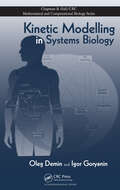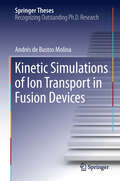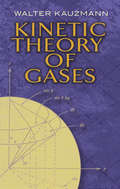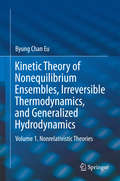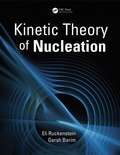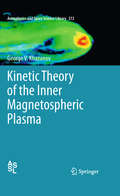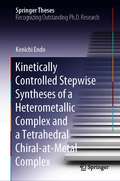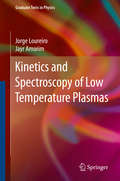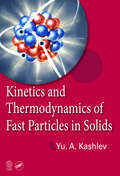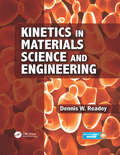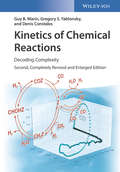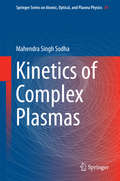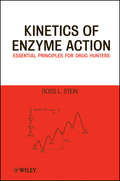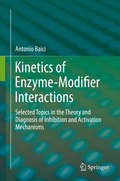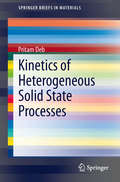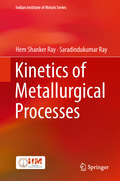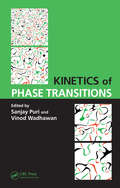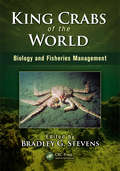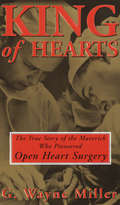- Table View
- List View
Kinetic Modelling in Systems Biology
by Oleg Demin Igor GoryaninWith more and more interest in how components of biological systems interact, it is important to understand the various aspects of systems biology. Kinetic Modelling in Systems Biology focuses on one of the main pillars in the future development of systems biology. It explores both the methods and applications of kinetic modeling in this emerging field.The book introduces the basic biological cellular network concepts in the context of cellular functioning, explains the main aspects of the Edinburgh Pathway Editor (EPE) software package, and discusses the process of constructing and verifying kinetic models. It presents the features, user interface, and examples of DBSolve as well as the principles of modeling individual enzymes and transporters. The authors describe how to construct kinetic models of intracellular systems on the basis of models of individual enzymes. They also illustrate how to apply the principles of kinetic modeling to collect all available information on the energy metabolism of whole organelles, construct a kinetic model, and predict the response of the organelle to changes in external conditions. The final chapter focuses on applications of kinetic modeling in biotechnology and biomedicine.Encouraging readers to think about future challenges, this book will help them understand the kinetic modeling approach and how to apply it to solve real-life problems.Downloadable Resources FeaturesExtensively used throughout the text for pathway visualization and illustration, the EPE software is available on the accompanying downloadable resources. The downloadable resources also include pathway diagrams in several graphical formats, DBSolve installation with examples, and all models from the book with dynamic visualization of simulation results, allowing readers to perform in silico simulations and use the models as templates for further applications.
Kinetic Simulations of Ion Transport in Fusion Devices
by Andrés de Bustos MolinaThis thesis deals with the problem of ion confinement in thermonuclear fusion devices. It is a topic of general interest, as it helps to understand via numerical simulations the ion confinement properties in complex geometries, in order to predict their behavior and maximize the performance of future fusion reactors. The main work carried out in this thesis is the improvement and exploitation of an existing simulation code called ISDEP. This code solves the so-called ion collisional transport in arbitrary plasma geometry, improving in this sense other existing codes. Additionally, it presents outstanding portability and scalability in distributed computing architectures, such as Grid or Volunteer Computing. The main physical results can be divided into two blocks. First, the study of 3D ion transport in ITER is presented. ITER is the largest fusion reactor (under construction) and most of the simulations so far assume the axis-symmetry of the device. Unfortunately, this symmetry is only an approximation because of the discrete number of magnetic coils used. ISDEP has shown, using a simple model of the 3D magnetic field, how the ion confinement is affected by this symmetry breaking. Secondly, ISDEP has been applied successfully to the study of fast ion dynamics in fusion plasmas. The fast ions, with energies much larger than the thermal energy, are a product of the device's heating system. Thus, a numerical predictive tool can be used to improve the heating efficiency. ISDEP has been combined with the FAFNER2 code to study such ions in stellarator (TJ-II, LHD) and tokamak (ITER) geometries. It has also been validated by experimental results. In particular, comparisons with the CNPA diagnostic in the TJ-II stellarator are remarkable.
Kinetic Theory of Gases (Dover Books on Chemistry)
by Walter KauzmannThis monograph and text was designed for first-year students of physical chemistry who require further details of kinetic theory. The treatment focuses chiefly on the molecular basis of important thermodynamic properties of gases, including pressure, temperature, and thermal energy. Includes numerous exercises, many partially worked out, and end-of-chapter problems. 1966 edition.
Kinetic Theory of Nonequilibrium Ensembles, Irreversible Thermodynamics, and Generalized Hydrodynamics
by Byung Chan EuThis book presents the fundamentals of irreversible thermodynamics for nonlinear transport processes in gases and liquids, as well as for generalized hydrodynamics extending the classical hydrodynamics of Navier, Stokes, Fourier, and Fick. Together with its companion volume on nonrelativistic contexts, it provides a comprehensive picture of the relativistic covariant kinetic theory of gases and relativistic hydrodynamics of gases. Relativistic theories of macroscopic irreversible processes must strictly conform to the thermodynamic laws at every step and in all approximations that enter their derivation from the mechanical principles. Upholding this as the inviolable tenet, the author develops theories of irreversible transport processes in fluids (gases or liquids). They apply regardless of whether the processes are near to or far removed from equilibrium, or whether they are linear or nonlinear with respect to macroscopic fluxes or thermodynamic forces. The irreversible covariant Boltzmann as well as the covariant form of the Boltzmann-Nordheim-Uehling-Uhlenbeck equation is used for deriving theories of irreversible transport equations and generalized hydrodynamic equations for either classical gases or quantum gases. They all conform rigorously to the tenet. All macroscopic observables described by the so-formulated theories therefore are likewise expected to strictly obey the tenet.
Kinetic Theory of Nucleation
by Gersh Berim Eli RuckensteinExplore a Kinetic Approach to the Description of Nucleation - An Alternative to the Classical Nucleation TheoryKinetic Theory of Nucleation presents an alternative to the classical theory of nucleation in gases and liquids-the kinetic nucleation theory of Ruckenstein-Narsimhan-Nowakowski (RNNT). RNNT uses the kinetic theory of fluids to calculate t
Kinetic Theory of the Inner Magnetospheric Plasma
by George V. KhazanovThe inner magnetosphere plasma is a very unique composition of different plasma particles and waves. It covers a huge energy plasma range with spatial and time variations of many orders of magnitude. In such a situation, the kinetic approach is the key element, and the starting point of the theoretical description of this plasma phenomena which requires a dedicated book to this particular area of research.
A Kinetic View of Statistical Physics
by Pavel L. Krapivsky Sidney Redner Eli Ben-NaimAimed at graduate students, this book explores some of the core phenomena in non-equilibrium statistical physics. It focuses on the development and application of theoretical methods to help students develop their problem-solving skills. The book begins with microscopic transport processes: diffusion, collision-driven phenomena, and exclusion. It then presents the kinetics of aggregation, fragmentation and adsorption, where the basic phenomenology and solution techniques are emphasized. The following chapters cover kinetic spin systems, both from a discrete and a continuum perspective, the role of disorder in non-equilibrium processes, hysteresis from the non-equilibrium perspective, the kinetics of chemical reactions, and the properties of complex networks. The book contains 200 exercises to test students' understanding of the subject. A link to a website hosted by the authors, containing supplementary material including solutions to some of the exercises, can be found at www. cambridge. org/9780521851039.
Kinetically Controlled Stepwise Syntheses of a Heterometallic Complex and a Tetrahedral Chiral-at-Metal Complex (Springer Theses)
by Kenichi EndoThis book describes novel synthetic methodologies for two kinds of structurally elaborate metal complexes: a heterometallic complex and a tetrahedral chiral-at-metal complex. The book provides the tools and inspiration to chemists for development of metal complexes with wide structural diversity than had previously been possible. For each of the two topics, existing synthetic methods for similar compounds are discussed first, and then new strategies are presented, followed by the demonstration of the synthesis of novel compounds supported by experimental results.Both of the final products in this research, a Co–Ni heterometallic complex covered in the first topic and a tetrahedral chiral-at-metal complex in the second one are difficult to obtain by using common synthetic methods for thermodynamic reasons. This research achieved highly selective syntheses of these compounds using newly designed strategies that enable precise kinetic control. Such an approach will be useful for synthesizing other new metal complexes.Since the last century, organic chemistry has flourished with the development of a variety of synthetic techniques that make precise kinetic control possible. Coordination chemistry of 3d or main-group transition metals has been mainly based on simple one-step reactions that yield only thermodynamic products. The publication of this book helps pave the way to kinetically controlled precise syntheses of various metal complexes.
Kinetics and Catalysis in Microheterogeneous Systems
by M. Grätzel and K. KalyanasundaramThis book provides a quantitative assessment of the advances in the area of catalysis and kinetics in microheterogeneous systems. It is an invaluable resource for chemists interested in catalysis and reaction kinetics, and physicists interested in semiconductors, metal clusters and catalysis.
Kinetics and Dynamics
by Agnieszka Dybala-Defratyka Piotr Paneth"Kinetics and Dynamics" on molecular modeling of dynamic processes opens with an introductory overview before discussing approaches to reactivity of small systems in the gas phase. Then it examines studies of systems of increasing complexity up to the dynamics of DNA. This title has interdisciplinary character presenting wherever possible an interplay between the theory and the experiment. It provides basic information as well as the details of theory and examples of its application to experimentalists and theoreticians interested in modeling of dynamic processes in chemical and biochemical systems. All contributing authors are renowned experts in their fields and topics covered in this volume represent the forefront of today's science.
Kinetics and Spectroscopy of Low Temperature Plasmas
by Jayr Amorim Jorge LoureiroThis is a comprehensive textbook designed forgraduate and advanced undergraduate students. Both authors rely on more than 20years of teaching experience in renowned Physics Engineering courses to writethis book addressing the students' needs. Kinetics and Spectroscopy of Low Temperature Plasmasderives in a full self-consistent way the electron kinetic theory used todescribe low temperature plasmas created in the laboratory with an electrical discharge,and presents the main optical spectroscopic diagnostics used to characterizesuch plasmas. The chapters with the theoretical contents make use of adeductive approach in which the electron kinetic theory applied to plasmaswith basis on the electron Boltzmann equation is derived from the basicconcepts of Statistical and Plasma Physics. On the other hand, the mainoptical spectroscopy diagnostics used to characterize experimentally such plasmasare presented and justified from the point of view of the Atomic and MolecularPhysics. Low temperature plasmas (LTP) are partially ionized gases with a broaduse in many technological applications such as microelectronics, light sources,lasers, biology and medicine. LTPs lead to the production of atomic andmolecular excited states, chemically reactive radicals, and activated surfacesites, which are in the origin, among others, of the deposition of thin films,advanced nanotechnology products, solar cells, highly efficient combustionmotors, and treatment of cancer cells.
Kinetics and Thermodynamics of Fast Particles in Solids
by Yurii KashlevKinetics and Thermodynamics of Fast Particles in Solids examines the kinetics and non-equilibrium statistical thermodynamics of fast charged particles moving in crystals in different modes. It follows a line of research very different from traditional ways of constructing a theory of radiation effects, which gives a purely mechanistic interpretatio
Kinetics in Materials Science and Engineering
by Dennis W. Readey"A pedagogical gem…. Professor Readey replaces ‘black-box’ explanations with detailed, insightful derivations. A wealth of practical application examples and exercise problems complement the exhaustive coverage of kinetics for all material classes." –Prof. Rainer Hebert, University of Connecticut "Prof. Readey gives a grand tour of the kinetics of materials suitable for experimentalists and modellers…. In an easy-to-read and entertaining style, this book leads the reader to fundamental, model-based?understanding of kinetic processes critical to development, fabrication and application of commercially-important soft (polymers, biomaterials), hard (ceramics, metals) and composite materials. It is a must-have for anyone who really wants to understand how to make materials and how they will behave in service." --Prof. Bill Lee, Imperial College London, Fellow of the Royal?Academy of Engineering "A much needed text filing the gap between an introductory course in materials science and advanced materials-specific kinetics courses. Ideal for the undergraduate interested in an in-depth study of kinetics in materials." –Prof. Mark E. Eberhart, Colorado School of Mines This book provides an in-depth introduction to the most important kinetic concepts in materials science, engineering, and processing. All types of materials are addressed, including metals, ceramics, polymers, electronic materials, biomaterials, and composites. The expert author with decades of teaching and practical experience gives a lively and accessible overview, explaining the principles that determine how long it takes to change material properties and make new and better materials. The chapters cover a broad range of topics extending from the heat treatment of steels, the processing of silicon integrated microchips, and the production of cement, to the movement of drugs through the human body. The author explicitly avoids "black box" equations, providing derivations with clear explanations.
Kinetics of Chemical Reactions: Decoding Complexity
by Guy B. Marin Gregory S. Yablonsky Denis ConstalesThis second, extended and updated edition presents the current state of kinetics of chemical reactions, combining basic knowledge with results recently obtained at the frontier of science. Special attention is paid to the problem of the chemical reaction complexity with theoretical and methodological concepts illustrated throughout by numerous examples taken from heterogeneous catalysis combustion and enzyme processes. Of great interest to graduate students in both chemistry and chemical engineering.
Kinetics of Complex Plasmas
by Mahendra Singh SodhaThe presentation in the book is based on charge balance on the dust particles, number and energy balance of the constituents and atom-ion-electron interaction in the gaseous plasma. Size distribution of dust particles, statistical mechanics, Quantum effects in electron emission from and accretion on dust particles and nonlinear interaction of complex plasmas with electric and electromagnetic fields have been discussed in the book. The book introduces the reader to basic concepts and typical applications. The book should be of use to researchers, engineers and graduate students.
Kinetics of Enzyme Action
by Ross L. SteinFew scientists have the knowledge to perform the studies that are necessary to discover and characterize enzyme inhibitors, despite the vested interest the pharmaceutical industry has in this field. Beginning with the most basic principles pertaining to simple, one-substrate enzyme reactions and their inhibitors, and progressing to a thorough treatment of two-substrate enzymes, Kinetics of Enzyme Action: Essential Principles for Drug Hunters provides biochemists, medicinal chemists, and pharmaceutical scientists with numerous case study examples to outline the tools and techniques necessary to perform, understand, and interpret detailed kinetic studies for drug discovery.
Kinetics of Enzyme-Modifier Interactions
by Antonio BaiciThe kinetic mechanisms by which enzymes interact with inhibitors and activators, collectively called modifiers, are scrutinized and ranked taxonomically into autonomous species in a way similar to that used in the biological classification of plants and animals. The systematization of the mechanisms is based on two fundamental characters: the allosteric linkage between substrate and modifier and the factor by which a modifier affects the catalytic constant of the enzyme. Combinations of the physically significant states of these two characters in an ancestor-descendant-like fashion reveal the existence of seventeen modes of interaction that cover the needs of total, partial and fine-tuning modulation of enzyme activity. These interactions comprise five linear and five hyperbolic inhibition mechanisms, five nonessential activation mechanisms and two hybrid species that manifest either hyperbolic inhibition or nonessential activation characteristics depending on substrate concentration. Five essential activation mechanisms, which are taxonomically independent of the mentioned basic species, complete the inventory of enzyme modifiers. Often masked under conventional umbrella terms or treated as anomalous cases, all seventeen basic inhibition and nonessential activation mechanisms are represented in the biochemical and pharmacological literature of this and the past century, either in the form of rapid or slow-onset reversible interactions, or as irreversible modification processes. The full potential of enzyme inhibitors and activators can only be appreciated after elucidating the details of their kinetic mechanisms of action exploring the entire range of physiologically significant reactant concentrations. This book highlights the wide spectrum of allosteric enzyme modification in physiological occurrences as well as in pharmacological and biotechnological applications that embrace simple and multiple enzyme-modifier interactions. The reader is guided in the journey through this still partly uncharted territory with the aid of mechanistically-oriented criteria aimed at showing the logical way towards the identification of a particular mechanism.
Kinetics of Evaporation (Springer Series in Surface Sciences #68)
by Eugeny I. Yurin Denis N. GerasimovThis monograph discusses the essential principles of the evaporationprocess by looking at it at the molecular and atomic level.In the first part methods of statistical physics, physical kinetics andnumerical modeling are outlined including the Maxwell’s distributionfunction, the Boltzmann kinetic equation, the Vlasov approach, and theCUDA technique.The distribution functions of evaporating particles are then defined.Experimental results on the evaporation coefficient and the temperaturejump on the evaporation surface are critically reviewed and compared tothe theory and numerical results presented in previous chapters.The book ends with a chapter devoted to evaporation in differentprocesses, such as boiling and cavitation.This monograph addressesgraduate students and researchers working on phase transitions andrelated fields.
Kinetics of Heterogeneous Solid State Processes
by Pritam DebKinetic studies have traditionally being extremely useful in characterizing several physical and chemical phenomena in organic, inorganic and metallic systems. It provides valuable qualitative, quantitative and kinetic information on phase transformations, solid state precipitation, crystallization, oxidation and decomposition. Unfortunately, no single reference comprehensively presents nonisothermal kinetic analysis method for the study of complex processes, determining the actual mechanism and kinetic parameters. This book provides a new method for nonisothermal kinetics and its application in heterogeneous solid state processes. In the backdrop of limitations in existing methods, the book presents a brief review of the widely used isothermal and nonisothermal kinetic analysis methods.
Kinetics of Metallurgical Processes (Indian Institute Of Metals Ser.)
by Hem Shanker Ray Saradindukumar RayThis book is intended as a text for upper undergraduate and graduate courses on kinetics of metallurgical processes for students of materials science, metallurgical engineering, and chemical engineering. Focusing on basic and essential topics, selected from the authors’ teaching and research, it serves as a comprehensive guide to metallurgical kinetics. Chapters 1–10 discuss the “logic” of various kinetics processes, while Chapter 11 explores the systematic analysis of raw rate data generated from controlled experiments. The final chapters illustrate how the fundamental concept of thermal activation is used to describe the kinetics of rate-dependent plastic deformation and creep fracture. With numerous examples, illustrations, and step-by-step tutorials, it is ideally suited for both self-study and classroom use. The examples were selected from research papers to highlight how the topics discussed can be, and are, used to solve real-world technological problems. Providing a comprehensive list of resources for further study, and end-of-chapter review questions to help students test their knowledge, it can be used for university coursework or as a text for professional development courses.
Kinetics of Phase Transitions
by Sanjay Puri Vinod WadhawanProviding a comprehensive introduction with the necessary background material to make it accessible for a wide scientific audience, Kinetics of Phase Transitions discusses developments in domain-growth kinetics. This book combines pedagogical chapters from leading experts in this area and focuses on incorporating various experimentally releva
Kinetics, Transport, and Structure in Hard and Soft Materials
by Peter F. GreenKinetics, Transport, and Structure in Hard and Soft Materials is the only single reference that discusses the connection between structure and mechanisms of atomic or molecular transport in different classes of materials, from metals and semiconductors to network glasses, polymers and supercooled liquids.Divided into four parts, Part
King Cecil the Sea Horse (Little Golden Book)
by Tish Rabe Christopher MoroneyWhen Sally and Nick need to learn about babysitting, the Cat in the Hat takes them to meet an expert: King Cecil the Seahorse! That's because when it comes to having babies, seahorses give birth in a very special way. The mom seahorse puts her eggs into a pouch on the dad, and he carries them there until the babies hatch (in his pouch) and swim out! Perfect for summer reading, nights with the babysitter, Father's Day--any day, really. This Little Golden Book based on an episode of the hit PBS Kids' TV show The Cat in the Hat Know a Lot About That! will keep kids laughing, teach them about a very unique animal, and even inspire conversations about gender roles!
King Crabs of the World: Biology and Fisheries Management
by Bradley G. StevensWith species existing in all subpolar seas, king crabs are one of the most valuable seafoods. Major fluctuations in their abundance have stimulated a flurry of research and a rapid expansion of the scientific literature in the last decade. King Crabs of the World: Biology and Fisheries Management consolidates extensive knowledge on the biology, sys
King Of Hearts: The True Story of the Maverick Who Pioneered Open Heart Surgery
by G. Wayne MillerFew of the great stories of medicine are as palpably dramatic as the invention of open-heart surgery, yet, until now, no journalist has ever brought all of the thrilling specifics of this triumph to life. This is the story of the surgeon many call the father of open-heart surgery, Dr. C. Walton Lillehei, who, along with colleagues at University Hospital in Minneapolis and a small band of pioneers elsewhere, accomplished what many experts considered to be an impossible feat: He opened the heart, repaired fatal defects, and made the miraculous routine. Acclaimed author G. Wayne Miller draws on archival research and exclusive interviews with Lillehei and legendary pioneers such as Michael DeBakey and Christiaan Barnard, taking readers into the lives of these doctors and their patients as they progress toward their landmark achievement. In the tradition of works by Richard Rhodes and Tracy Kidder,King of Heartstells the story of an important and gripping piece of forgotten science history. From the Hardcover edition.
